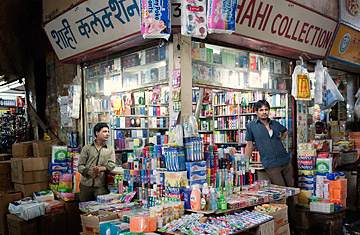
A shop in Mumbai's Crawford Market is characteristic of the mom-and-pop establishments still dotting India.
(2 of 2)
Spirit of '91
Can there be an India 3.0? The weight of the country's problems has moved Singh to alter course. In September, he reinstated the previously thwarted opening of India's retail sector and invited foreign airlines to invest in the nation's struggling carriers. Less than a month later, he increased the limit on foreign investment in Indian insurance companies. Now there is talk that the government will form a national investment board comprising several ministers to fast-track important infrastructure-and-industrial projects mired in an obstructive approval process. The Finance Ministry is also hinting it will revoke that sentiment-sapping retroactive tax measure. This time around, Singh hasn't melted as his opponents turned up the heat. He refused to retract his retail reform even after a party bolted from his ruling coalition in protest. "We are not backing off what we thought was the right thing to do," says Montek Singh Ahluwalia, deputy chairman of the government's Planning Commission.
Will this last? Since 1991, reform has often ebbed and flowed on the vicissitudes of democratic politics, and with elections slated for 2014, partisan posturing could quickly smother economic reform once again. "There is a lot of politicking," says Godrej, "something quite similar to what is going on in the U.S. right now, where politicians are allowing political differences to be above economic sense." And even once decisions are taken, the resistant bureaucracy doesn't implement the changes efficiently enough. "There is too much placed on just announcements," says N.K. Tyagarajan, CEO of business-services provider Genpact. "There are so many ifs and buts [with every reform], there is so much fine print, execution takes longer than it should."
The Road Not Paved
A lot remains to be done. the government must simplify procedures and clarify confusing regulations on everything from paying taxes to acquiring land in order to spur investment. The lingering remnants of the License Raj have to finally become history. Consulting firm McKinsey figures that building a power plant in India takes five to six years — roughly twice as long as in China — in part because of regulatory hurdles. Until such roadblocks are removed, the nation's decrepit infrastructure — roads, ports and power systems — won't get the serious upgrade it requires. Fearing an outage that would cripple his operations, Genpact's Tyagarajan has to absorb the burdensome expense of maintaining three backup electric-generation systems. "India should be worried its competitiveness will change," he says. Without further reform, "the costs of doing business will keep going up."
India's politicians often paint reform as a necessary evil, forced upon them in desperate times, not the route to a brighter future. "We need to sell the advantages of economic development to society," says FICCI's Kanoria. "The government has not sold reform as part of a dream." No other major economy might be poised for faster growth over the next several decades. Unlike China's, rapidly aging because of its one-child policy, India's population is young and growing, giving it a demographic edge. In a 2011 report, Citigroup economists forecast that India, not China, will be the largest economy in the world by 2050. Indians could also become the planet's most important consumers, and thus a key driver of global growth. The Brookings Institution, in Washington, D.C., has projected that by 2030 India's middle class will spend more than China's or the U.S.'s. "We look like we are muddling along, but we get back into the groove," says Mahindra. If and when India fully does so, then it will finally achieve its promise.
— with reporting by Krista Mahr / New Delhi and Shashikant Sawant / Mumbai
